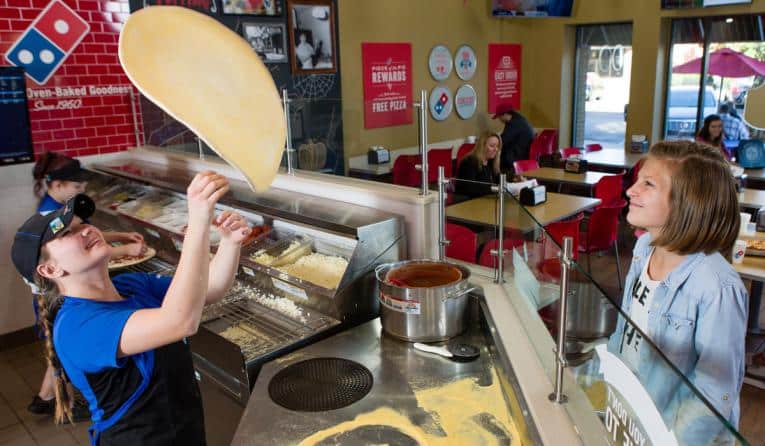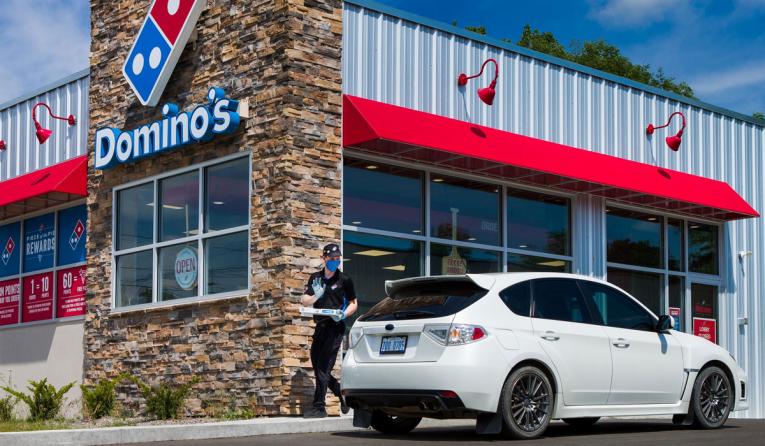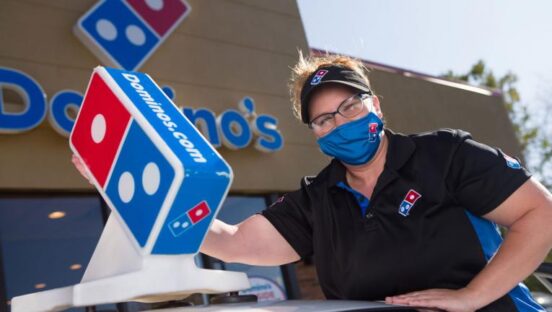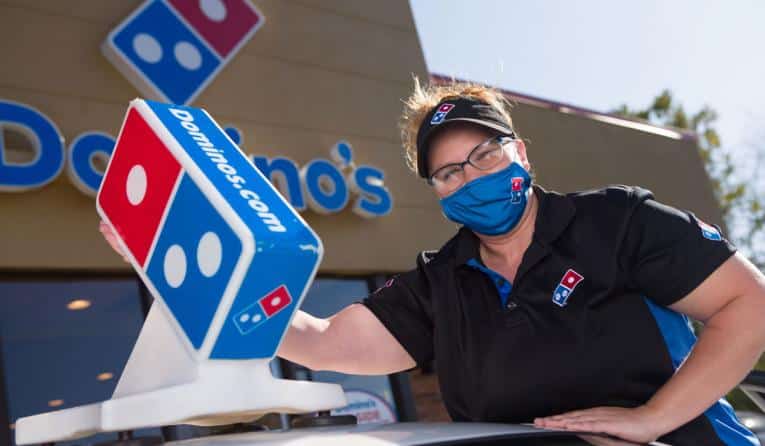Domino’s CEO Ritch Allison isn’t pleased margins increased 140 basis points to 24.5 percent at company-run stores in the second quarter.
That’s because he knows the reality. Domino’s operated with fewer employees than it would like to have in many stores across the country.
It puts significant pressure on operators to meet pent-up demand while also maintaining a superior level of service, the CEO said. But the brand has managed so far. Even while lapping a hugely successful Q2 2020, U.S. same-store sales increased 3.5 percent, and 19.6 percent on a two-year stack. International units lifted 13.9 percent, the highest in at least 18 years, and 14.2 percent on a two-year basis—the best since Q1 2016. That represented the 41st straight quarter of domestic comps growth and the 110th consecutive period of international gains.
However, the labor crisis’ shadow looms large, and Domino’s solution is one shared by many—implementing wage increases across corporate store markets. And when the chain thinks about how to offset wage hikes and still maintain a solid four-wall economic model, Allison noted pricing is “certainly one of the levers out there.”
READ MORE: How Domino’s Plans to Compete Against its 2020 Boom
For U.S. comps, growth was driven by more items per order, but also modest menu price and delivery fee increases. In regard to national offers around the chain’s $5.99 Mix and Match and $7.99 Carryout deals, Allison said the brand has “continued to test those on a very frequent basis.”
“Not just looking at which offers would drive the most top line, but more importantly, what’s going to drive the strongest four-wall EBITDA for our stores,” Allison said Thursday during Domino’s Q2 earnings call. “[The] $5.99 and $7.99 [deals] have continued to emerge from the many, many offers that we continue to test on a frequent basis, but what I will tell you is, if we find an offer or if the dynamics change that a different offer drives higher levels of profits for our franchisees, then we would move to that offer.”
“[Our] $5.99 and $7.99 are not sacred,” he continued. “The only thing that is sacred is that we’re going to bring value to the consumer because that’s what drives order counts, and ultimately order counts over time are correlated with sales and profitability at the store level.”
Other quick-service chains are facing the same dilemma. Chipotle revealed in June it planned to raise menu prices 3.5 to 4 percent to offset raising the average wage of workers to $15 per hour. The fast casual has a 100 percent company-owned model, so it controls the pricing and wages at all of its units. At Domino’s, only 5.7 percent of U.S. restaurants are corporately owned. So that’s where its direct reach ends.

Domino’s doesn’t monitor franchise staffing levels and has no say in how operators implement menu price increases or changes in pay. Allison said the company can only lead by example.
“One of the most important things about running corporate stores is that we’re out there across the country feeling exactly what our franchisees are feeling,” Allison said. “So when they’re feeling pinched on staffing and wages and other things, we feel it in our own business, as well, and it allows us to make maintain a level of alignment that’s just impossible to have if you’ve sold all of your corporate stores over time.”
Allison acknowledged with staffing challenges, Domino’s hasn’t accomplished the type of service improvements it was hoping for in 2021. The chain has slipped “a minute or two” in average delivery times.
The key to turning that around is more than just gathering additional team members—it’s about becoming more efficient in stores so delivery drivers never have to leave their vehicle. For example, Domino’s no longer ask employees to pre-fold boxes, which saves time and leads to better-looking stores, and the chain rolled out GPS software that helps drivers become more familiar with the surrounding area. Additionally, the brand is using machine learning to predict sales and match the right number of team members.
Despite headwinds, Domino’s experienced positive delivery same-store sales in Q2 fueled by ticket growth, proving to Allison the brand’s own delivery fleet is still a more efficient model and provides better value than third-party aggregators. For guests, it means charging a single, transparent delivery fee, and for restaurant operators, it means charging a marginal amount for digital orders.
“We don’t exactly know yet how all this will ultimately shake out and all of the dynamics that may shift over time, but we’re really focused on maintaining a competitive position with both of those groups—the customers and the restaurant operators.”
READ MORE: As Third-Party Delivery Looks for Answers, Domino’s in ‘Good Spot’
Domino’s overall carryout business has withstood staffing challenges as well. In Q2, the chain’s takeout business saw positive comps, due to a balance of order count and ticket growth. The channel took a hit during the pandemic, but as restrictions have lifted nationwide, Domino’s is actually seeing higher sales in markets with fewer restrictions thanks in part to the big comeback of carryout.
The channel returned to pre-COVID levels in terms of orders per store in the second quarter, but when it comes to the mix between delivery and carryout, the company is still slightly below pre-pandemic marks. Allison said that’s driven by the fact that delivery order counts on a two-year basis are significantly higher than they were in 2019. Still though, the CEO thinks the surge in carryout orders is an initial sign that the business is coming back, and carside pickup will continue to play a major role in that growth.

“When we take a look at the business in total, the four-wall economics of the business are still incredibly strong, the cost of entry or what it takes to get a Domino’s Pizza opened relative to other [quick-service restaurants] is still very modest,” said Domino’s CEO Ritch Allison. “So the cash-on-cash returns in the business are still very strong. And that’s really what drives the appetite for development.”
The brand worked vigorously to prop up its carside delivery business in the past few months, with a 49 percent off promotion in May, and now a guarantee that stores will bring orders to cars in under two minutes. Allison said franchisees have embraced it, and stores are consistently serving orders well under two minutes, even with short staffing. The beneficial growth of carside is two-fold. For one, it’s a way for Domino’s to compete with drive-thru, knowing that it will never reach 100 percent pickup windows. And two, the order-ahead digital nature of the process allows Domino’s to invite customers to its loyalty program, increase ticket sizes, shorten transaction times, and use less labor.
Right now, digital mixes about 75 percent, but Allison knows it can be higher.
“How high is high, I don’t know, but I know it’s higher than 75 percent,” he said. “The benchmark that we use in Domino’s world to inspire everyone else is China where more than 19 out of every 20 orders come through digital channels.”
Domino’s opened a net of 238 stores in Q2, growth of more than 5 percent year-over-year. That includes a net of 203 international stores and a net of 35 U.S. outlets. The brand finished Q2 with 18,057 stores globally, including 6,426 in the U.S. and 11,631 internationally.
Although the brand is on track to reach its target of 6 to 8 percent unit growth, Allison said the number of net domestic openings in Q2 was softer than expected due to staffing challenges and construction, permitting, and construction delays. But the pipeline remains strong, and has resulted in larger expansion. On a trailing four-quarter basis, Domino’s pace of net store growth has increased from 624 in Q4 2020 to 884 in Q2.
Domino’s grew its global store count by more than 5,100 locations in the past five years, and recently celebrated the opening of its 18,000th store in La Junta, Colorado. Allison emphasized franchisees have a definite desire to expand their store count—it’s just some macroeconomic factors are getting in the way, like staffing and having teams ready for opening day.
“You won’t be surprised to hear that franchisees, just as we are, are concerned about staffing, about labor rates and where those are going over time, thinking about commodity costs and where those are going—all the things that you would expect restaurant operators to be concerned about,” Allison said.
“But when we take a look at the business in total, the four-wall economics of the business are still incredibly strong, the cost of entry or what it takes to get a Domino’s Pizza opened relative to other [quick-service restaurants] is still very modest,” he added. “So the cash-on-cash returns in the business are still very strong. And that’s really what drives the appetite for development.”
Revenues increased $112.4 million, or 12.2 percent, in the second quarter. Net income decreased $2 million, or 1.7 percent, against the prior year. Global retail sales grew 21.6 percent, including 7.4 percent at U.S. stores and 39.7 percent internationally.








